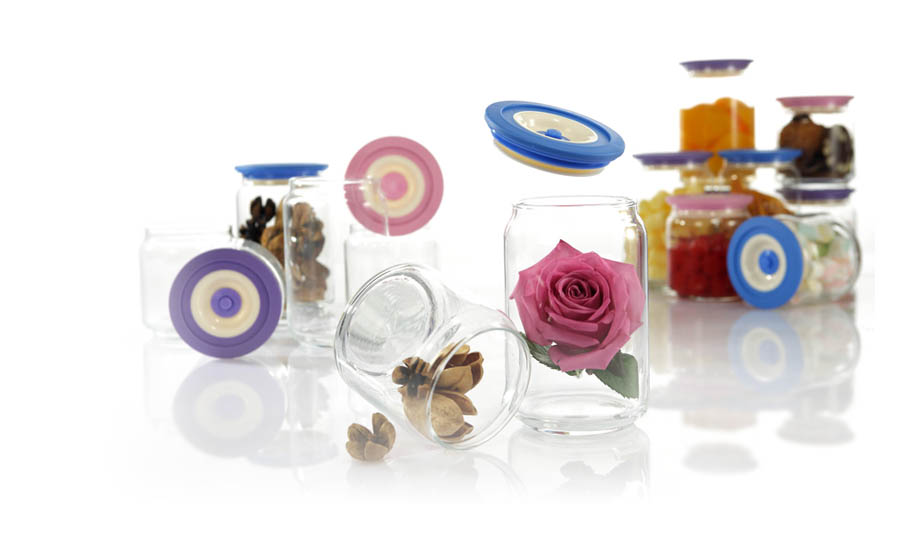Plastic tea bags and storage
Reminder: fresh teas are best stored in a dry and cool place, without smells, little air and away from sun light.
The above blurry picture was taken from the inside of a silver tea bag like the one on the left hand picture. It shows that this kind of plastic tea bag lets some light through. This may harm very fresh and tender leaves like green tea or light Oolong. (For roasted teas, I don't think a little light won't matter much after all the heat they got through the roasting.)
 Is it better to transfer the leaves to a tea box or tea jar then?
Is it better to transfer the leaves to a tea box or tea jar then?
Fresh teas are meant to be drunk at a quick pace, within a season or 2. That means that the volume of tea will diminish over time. You would have to constantly transfer the remaining tea in smaller and smaller containers to minimize the air inside your tea box/jar.
Plastic bags offer a more practical way to minimize the contact of tea leaves with air: just fold the bag tightly and clip it tightly closed. And then, in a second step, put this plastic tea bag in a box to block the light.
Note: Not all plastic bags let light through. This dark green and gold tea bag, for instance, is thicker and blocks all light.
By the way, I've bought this new, professional vacuum sealer this week. It will give me more flexibility to make tea samples. Proper tea storage is imperative to the shelf life, quality and flavor of your tea. Learn how to keep your tea fresh and delicious with these easy tea storage tips.
Storage Conditions to Avoid
Avoiding just five storage conditions will make a huge difference in the shelf life of your tea. These factors are light, heat, moisture, odor and air.
Light and UV rays degrade your tea very quickly. Avoid buying tea from vendors who store their clear tea in glass or plastic containers and avoid storing your tea in anything clear unless you plan on keeping it in a dark cabinet.
Heat also degrades your tea. Avoid placing it in the sun (see also: Light) or near heat sources, like a stoves and ovens.
Moisture causes problems, too. Tea is shelf stable because it is dry. Unfortunately, it absorbs water from the air very easily. Until it’s ready to brew, keep it away from boiling water (see also: Heat). You’ll also benefit by avoiding other humid areas, like above a dishwasher vent or in a refrigerator. Obviously, you won’t want to expose your tea to liquid moisture either unless, of course, you’re brewing it.
(Note: Storing tea in the fridge is an incredibly common mistake. The only teas that should be stored in a fridge are tightly sealed canisters of Japanese green teas, and those should be consumed very shortly after they are opened.)
Odor is something that tea absorbs very easily. This tea trait allows for the creation of amazing scented teas, such as Jasmine Pearls. It also means that storing your tea near a spice cabinet, trashcan or other source of odor is a no-no.
Air exposure increases the chances that your tea will absorb moisture and odors. Avoid leaving tea out, sealing it with excess air in the packaging or storing it in porous packaging materials, like paper bags.
How to Store Tea Properly
Avoiding the five “tea killers” above means you’ll have to consider the location, packaging material and packaging mechanism you’re using to store your tea. Here are the best practices for each:
Tea Storage Materials
· Use opaque packaging if possible.
· Be sure your packaging is food safe. (For example, don’t use a pencil case to hold tea.)
· Glazed ceramics, non-reactive metals and opaque, non-leaching plastics all make great packaging materials.
· Wood packaging may be a workable option, but be aware that many wood containers have odors that can influence the tea’s taste.
· The bags that suppliers sell tea in vary widely in terms of quality. For long-term storage, make sure your bags are multi-ply with an inner layer of foil or glassine (a substance similar to wax paper). This avoids contamination by water, air or grease.
Note: Plastic “sandwich bags” are not a good storage option, as they expose your tea to light, odor and air.
Tea Storage Mechanisms
A tight seal is key. If the mechanism can hold water, it can protect tea. Good options include:
· Double lids (these are common with metal tea canisters)
· Odor-free silicone seals (also common with metal canisters)
· Multi-ply bags with resealable plastic “zippers”
Reference by : www. coffeetea.about.com

















